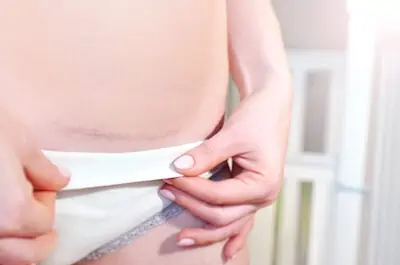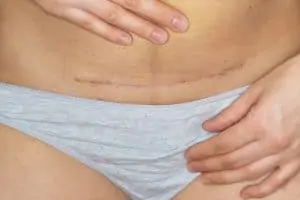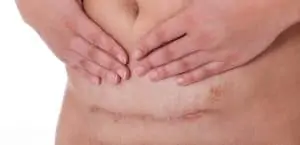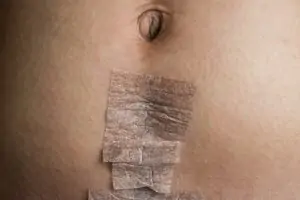Let me tell you something…right after your c-section, you will not want ANYTHING to touch your incision area. Even getting touched by a baby foot grazing, the area feels like torture.
But as the weeks of your recovery churn, this will all pass. You’ll feel numb in the area, and things will be painful, but this all starts to subside.
Eventually, you will be able to touch your skin there without shrieking in pain. When you do, some of you may be surprised to feel your c-section scar is raised and hard.
But is that normal?
In short, it is normal. But it only happens to some. And there are things you can do to minimize the hardness around your c-section incision and keep it healing healthfully in general, which I’ll cover further below.
What Is That Hardness Around the C-Section Incision?
As your c-section incision heals, it should feel like the rest of your skin. In the beginning, when you touch it, it may feel slightly raised. It will most definitely be sensitive too. But after time, you may notice it’s still hard.
What’s up with that?
Well, scar tissue can form over the wound. This is to help repair it and protect that injury. But in some instances, extra scar tissue grows on it, creating smooth yet hard growths. These are called keloids.
If your c-section incision is hard underneath, there may have been a break in your body’s tissues. Your body produces more collagen to help it heal, and thus, this builds up where the tissues are damaged to strengthen the wound.
For a few months, new collagen forms, and the blood supply increases. This can raise the scar and make it lumpy. It may also look a bit red.
But don’t worry too much because some collagen will break down at the wound site. The blood supply will also reduce, and the scar will gradually go to a smoother, softer, and paler state.
These scars are permanent, but in the next 2 years, they should fade a bit. However, after 2 years, likely, it’s not going to fade much more than that.
A c-section scar that is raised and hard in appearance is known as a hypertrophic scar. It becomes thick and hard but doesn’t move beyond the incision lines. You can use silicone sheets to minimize the scarring but talk to your doctor first. You’re not supposed to use them until the incision has completely healed and your doctor says it’s ok.
How to Keep C-Section Scars from Looking Too Prominent
My c-section scar is still there, and it’s been years. But it’s very faint now, and you can barely see it. Even in a bikini, no one can see it. The doctor did a great job of keeping the incision of my second c-section on the old scar line. It’s really minimal.
To help your c-section scar heal the best, try these tips.
- Don’t use anything unless your doctor says so
Special oils and scar creams shouldn’t be used as the incision heals. You’ll be able to use these things soon enough, but ask your doctor when you can use them.
- Nourish yourself
Foods rich in vitamins, minerals, and antioxidants will help your body with amazing self-healing powers. Aim to eat as many wholesome and healthy foods as possible while your body heals.
- Try massage

Only when your c-section incision has healed, and the doctor says it’s ok, you can massage the area around your scar. This helps get the skin and muscles moving for optimal scar healing.
- Protect with sunscreen
After healing, if your c-section is exposed to the sun, keep it from getting darker by covering it with sunscreen. Remember to reapply it as needed every 80 minutes and after you’ve gone in the water.
- Look for silicone strips
Again, ask your doctor first before you try using them. If they say you can use them, you can apply silicone strips on your scar to fade and flatten it.
- Consider other solutions
If you’re still not happy with how your c-section scar looks, if it is completely healed, you could consider a tattoo to cover it up or scar removal from a plastic surgeon. Some mamas do the latter option along with a tummy tuck, but this is generally only recommended if you have excess skin on your belly and a c-section scar overhang after about 12 months of the scar’s healing.
Ultimately, you’ve got to wait and see how things look as you heal. But by taking care of yourself, you should avoid hard and lumpy c-section scars. And if they still turn out like that, you’ve got plenty of solutions to help you.
Try to love yourself for the way you are, though. I know we all like to pick at ourselves and overanalyze things, but we’re all beautiful in our ways, even with our scars.
Leslie Berry lives with her husband and two young daughters in Los Altos, California, where she loves helping other moms get comfortable with motherhood and embracing the insanity with facts peppered with laughs.
She loves eating too much sushi, exercising, and jamming out on her Fender. Read more about Leslie here.






